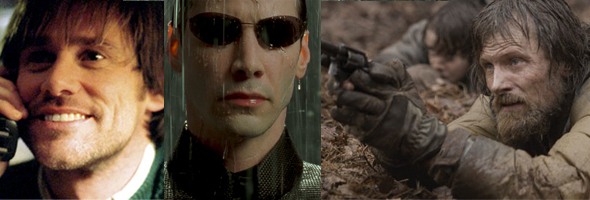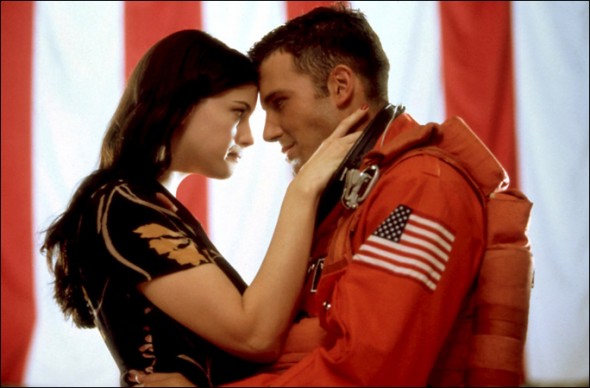ACTION
If the films of the 1990s gave us reasons for the end of the world, the films of the 2000s took those reasons to their logical conclusion. We were shown what the end of the world will look like, and shown who’d be there when the dust settled. Last fall it was a father (Viggo Mortenson) and his son (Kodi Smit-McPhee), and there most precious resource was a gun. In January, it was Denzel Washington and his most precious resource was a book. That and a Samurai sword.
The days of apocalyptic glimpses are far behind us (remember 1992’s Terminator 2 and its inspired, momentary glances forward?). These days, terminators are fought 20 years from now in the middle of human extermination and heroes like John Connor have to deal with the poor decision-making of their ignorant leaders, yelling cynical, culturally-relevant lines like “If we stay the course, we’re dead! We’re all dead!”
The 1990s’ curious/adventurous predictions of future technology and its ability to destroy the world were replaced with films (at the tail end of the 1990s and throughout the 2000s) so technologically advanced that they mirrored the technology responsible for said imagined disasters. Films like The Matrix, The Lord of the Rings and Avatar employed computers to develop creatures that, while not quite photo-realistic, appear very much alive. Explosions occur right in front of our eyes, yet exist only inside the mind of a device.
American cinema appeared to accept the impending apocalypse this past decade, with even the most studio-debted of directors offering both the highest of stakes and the highest of consequences. In 1990s disaster flicks like Armageddon and Independence Day the world is set to end via outside invaders, mostly saved by government-led heroes. The body count stayed relatively low back then, with only cities like New York or Paris partly destroyed. In 2000s disaster flicks like 2012, the only combatant against the end is running (or driving) really fast and the government goes out of its way to protect only the rich, letting the rest die horrible deaths. And they do die horrible deaths, the body count in the billions or, at the very least, high millions.
This progression makes sense. As of today, the United States still fights an unpopular war on two fronts with the end as ambiguous as ever, while the prospect of global warming has grown so possible that the idea of an “issue” movie like Waterworld doesn’t seem that goofy anymore. Fortunately, The Postman still does. Or does it?
Blockbusters certainly lost a step in the past decade, right as they were gaining one. Though the effects are worth every penny (now-a-days, that’s a lot of movie ticket pennies), the stories are so stale the filmmakers should be paying their viewers. Even the highest-grossing film of all time failed to be as inventive as 1997’s Romeo and Juliet-inspired Titanic, the 2nd highest grossing movie of all time. Both were directed by James Cameron. It’s nice to know that some things don’t change, I guess.
Thankfully, creative fiction within the film system does still exist, but not not the way it used to. The Gen-X- influenced “system criticizing the system” sub-genre that became a staple of the 90s (The Player, To Die For, Reality Bites, An Alan Smithee Film: Burn Hollywood Burn, etc.) has all but been extinguished. Anyone remember S1Mone? What Just Happened? The metafiction of today reaches far beyond anyone one common evil, instead exploring the universal nemesis of American narcissism: each and every one of us. What’s more, no answer is ever provided these days. Charlie Kaufman‘s largely to blame. Or praise. It gets confusing.
In 1990s metafiction like The Truman Show, the conclusion hopes for a world free of media voyeurism and true experience. In 2000s metafiction like Charlie Kaufman’s Eternal Sunshine of the Spotless Mind even true love can’t survive the promise of technological advancement, which, of course, only leads to more conflict and heartbreak. Voyeurism isn’t a possibility – it’s a last hope. Kaufman’s directorial debut and logical follow up, Synecdoche, New York, quite literally burns down the independent, artistic endeavor in front of its viewers’ eyes, most of whom are most likely striving for some measure of artistic grace themselves. Apparently, they won’t achieve it.
Something has burnt down hasn’t it? Somewhere during this past decade? A cynicism that lets shit (Transformers 2: Revenge of the Fallen) flourish while art (The Brothers Bloom) loses an audience and, with it, its ultimate voice.
The Hollywood that once put its money behind young pioneers in the 1970s (Coppola, Lucas, Spielberg, Scorsese, Rafelson, etc.) now presents them with awards while they either strive for that youthful vigor of the past (The Departed, Tetro, No Good Deed) or make sequels to those things that made them great in the first place. They never forget to say thank you of course, for the past but also, and most importantly, the present. After all, what would last decade’s dividends look like without Revenge of the Sith and Kingdom of the Crystal Skull? Nearly $2 billion short.
The shift continues overseas. France has become the place where action was reborn under names like Luc Besson and Louis Leterrier and genre films like District B13 and its sequel. A country once storied for invention via New Wave artists like Godard, Varda and Rohmer now lives on re-invention by visual artists with a penchant for cliched storytelling? Sound like anyone we Americans know? Not that these French genre films aren’t good. They’re very good.
If you want the best genre films around, look no further than France. Their Oscar nominee Un Prophete is a gangster film for our time, sitting next to Italy’s Gomorrah as a psychological examination of the nature of organized crime, employing a deep central character to breakdown the condition, a la Michael Corleone.
And so the world of film continues to bend genre barriers, waiting for that next breakthrough.
Experiments in narrative these days slip out of places like Norway (Reprise, shown above) and Romania (4 Months, 3 Weeks and 2 Days), where cinematic revolutions are helping define new aspects of culture in their respective countries. Realist stories are meshed with enigmatic cameras to create something slick and painful to watch. Maybe there’s hope yet.
No matter the country or movement, one creative factor survives: auteurism. Never before has the ambition of an individual vision been more prevalent in films both good and bad. Young sparkplugs like the Danish Nicolas Winding Refn are picking up where middle-aged auteurs like Lars Von Trier left off. Even B-movies like The Boondocks Saints II: All Saints Day have a skewed, individualistic sensibility to its camera (Crank: High Voltage anyone?). It echoes the lack of collaboration present in these fictional apocalypses – everyone’s out for themselves, right or wrong. Everybody’s making their own Synecdoche, New York, or at least trying to.
The young movers-and-shakers are making names for themselves independently, using words like Mumblecore to define their process. Once they’ve toured enough festivals and shook enough hands they get to star in films like Greenberg and direct Ryan Gosling in neo-noir adaptations like Drive.
And though it may be universal (not Universal, thank God), it’s all very American, and maybe that’s not as bad as it sounds. Maybe film, as visual creative expression, is starting from scratch while tent-pole movies slowly begin to implode due to sky-high budgets and nervous executives. Or maybe both independent film and studio film are moving to a place of co-existence – films like Humpday and Paranormal Activity have major studios like Paramount re-thinking film budgets and distribution, creating sub-studios to support the shift.
Maybe, in this next decade, we’ll see the curiosity of the 1990s mesh with the technological advancement/narrative cynicism of the 2000s to produce a smorgasbord of emotions that will ultimately spell the end of the world. Or the beginning of a new one.
Either way, movies will be around until the bitter end, whether they cost $15,000 or $300 million.
CUT
What’s next for cinema in this new decade? Speak your mind!




